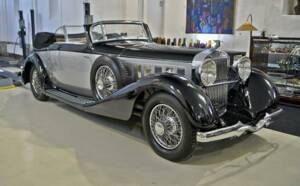- Car
- Hispano-Suiza
- Hispano-Suiza J 12 (1 offer)
Hispano-Suiza J 12 classic cars for sale
The Hispano-Suiza J 12 stands as the Spanish-French marque’s crowning achievement, combining technical precision with stately coachbuilt bodies. Limited in production and boasting a 12-cylinder engine, it represents the pinnacle of pre-war luxury motoring. Find out more about this rare masterpiece from one of automotive history’s most exclusive brands.
Search results

History of the Hispano-Suiza J 12
The Hispano-Suiza J 12 debuted in 1931 as the flagship of the renowned Spanish-French manufacturer, known for its technical innovation and luxury. Developed under the direction of chief engineer Marc Birkigt, the J 12 exemplified the brand’s focus on unmatched engineering, introducing a V12 engine that set new standards for smoothness and refinement. Although production numbers were never high, each J 12 was a bespoke chassis, typically shipped to Europe’s leading coachbuilders for custom bodies. This model was positioned for royals and heads of state, ensuring exclusivity from its first delivery until the final unit left the works in the late 1930s.
Model history
The J 12 succeeded the H6 series, moving Hispano-Suiza into the V12 segment for the first time. Its run spanned from 1931 to just before the outbreak of World War II. All were built as Type 68, but individuality came with custom coachwork by houses like Saoutchik and Vanvooren. Few were made due to the J 12’s astronomical price and the turbulent pre-war market, making survivors among the rarest of all Hispano-Suizas. There was no direct successor, as car production at Hispano-Suiza ended with the onset of global conflict.
Highlights and special features of the Hispano-Suiza J 12
Every Hispano-Suiza J 12 is a marvel of engineering. Its 9.4-litre V12 made it one of the most powerful luxury tourers of its era. The ‘Type 68’ chassis offered advanced features, including servo-assisted brakes—technology also adopted by Rolls-Royce and other contemporaries. The J 12 was distinctive for its pairing of mechanical prowess with tailor-made bodywork, tailored to customer demands at the highest luxury levels.
Technical data for the Hispano-Suiza J 12
Special editions and collectible versions
Nearly every J 12 is unique due to its coachbuilt body. Some notable builds came from Vanvooren, Saoutchik, and Letourneur et Marchand. Several cars were commissioned by royalty and dignitaries across Europe, making provenance a significant attribute in the collector world. There was no official limited series, as the nature of production was already extremely exclusive.
Weak spots and common issues
Given their rarity and age, J 12s require highly specialised care. Parts supply is strictly bespoke, especially for the V12 engine and unique drivetrain components. Expertise in early V12 design, braking systems, and period electrical systems is crucial. As almost all examples feature unique bodywork, restoration demands relations with coachbuilders experienced in ash framing and aluminium or steel panelwork. Prospective owners should budget for ongoing, meticulous attention and accept the need for hand-crafted replacement components.
Engine and performance, transmission and handling
The centerpiece of the J 12 is its 9.4-litre V12, delivering exceptional smoothness and effortless power at low revs. This facilitated serene cruising at higher speeds than many contemporaries, despite its substantial weight when bodied as a limousine or grand tourer. Most examples came with a four-speed manual gearbox, as was standard for the period. The servo-assisted brakes, a hallmark of the Hispano-Suiza approach, set new benchmarks in safety. Handling is stately and sure-footed rather than nimble, befitting the coachbuilt bodies and long wheelbase. Notable body styles include four-door saloons by Vanvooren and dramatic cabriolets by Saoutchik, each reflecting the peak of 1930s automotive excellence. These vehicles highlight Hispano-Suiza’s technical leadership and individual craftsmanship.
Interior, comfort, exterior, and design
The J 12’s design is inseparable from the artistry of Europe’s finest coachbuilders. Interior trim often featured hand-crafted wood veneers, bespoke instrumentation, and sumptuous upholstery. Exterior designs ranged from formal limousines to striking convertibles and coupés, each tailored to the original client’s specifications. Period options included custom luggage, integrated vanity compartments, division windows, and even armour plating for state use. Colour schemes were chosen to suit individual tastes, with many cars featuring unique paint and interior combinations, a testament to the bespoke approach.
Other features and details
With a small production run, most J 12s are intimately documented. Paperwork, provenance, and documentation of original bodywork are often vital to value and restoration. Some vehicles include state history, diplomatic usage, or modification histories, which are of high interest to collectors and historians alike.
Summary
The Hispano-Suiza J 12 is a rarefied example of pre-war luxury motoring, noteworthy for its advanced V12 engine, bespoke construction, and almost singular market presence. Each car tells a unique story, embodying a high point of automotive craftsmanship and innovation before the Second World War halted production. Today, the J 12’s value and fascination lie not merely in its engineering but also in its individual history and unparalleled exclusivity.
